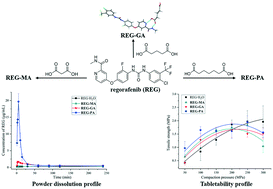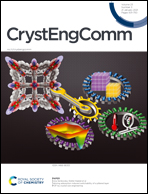Cocrystals of regorafenib with dicarboxylic acids: synthesis, characterization and property evaluation†
Abstract
Regorafenib (REG) is an oral multikinase inhibitor used for the treatment of gastrointestinal stromal tumors, metastatic colorectal cancer and advanced hepatocellular carcinoma. REG exists in various crystal forms and its monohydrate form (REG·H2O) is selected as the commercial form. However, the clinical efficacy of REG is severely limited by low oral bioavailability due to its poor aqueous solubility. With the intention to expand the solid forms and to improve the aqueous solubility at the same time, three cocrystals of REG with malonic acid (REG–MA), glutaric acid (REG–GA) and pimelic acid (REG–PA) were successfully synthesized by liquid-assisted grinding and/or the slurry methods. The obtained cocrystals were fully characterized by X-ray diffraction analysis, thermal analysis, and Fourier transform infrared and proton nuclear magnetic resonance spectroscopy, and were then subjected to powder dissolution, dynamic vapor sorption, stability and tabletability investigations. As compared to REG·H2O, REG–MA exhibits comparable dissolution behavior, while REG–GA and REG–PA demonstrate significantly enhanced apparent solubility and dissolution rates without compromising the hygroscopicity and physicochemical stability of the drug. In addition, the formation of the cocrystals also improves the tabletability of the powdered samples. These results suggest that REG–GA and REG–PA have great potential to be developed as new, more efficient formulations of REG.

- This article is part of the themed collection: Crystal Engineering Techniques


 Please wait while we load your content...
Please wait while we load your content...